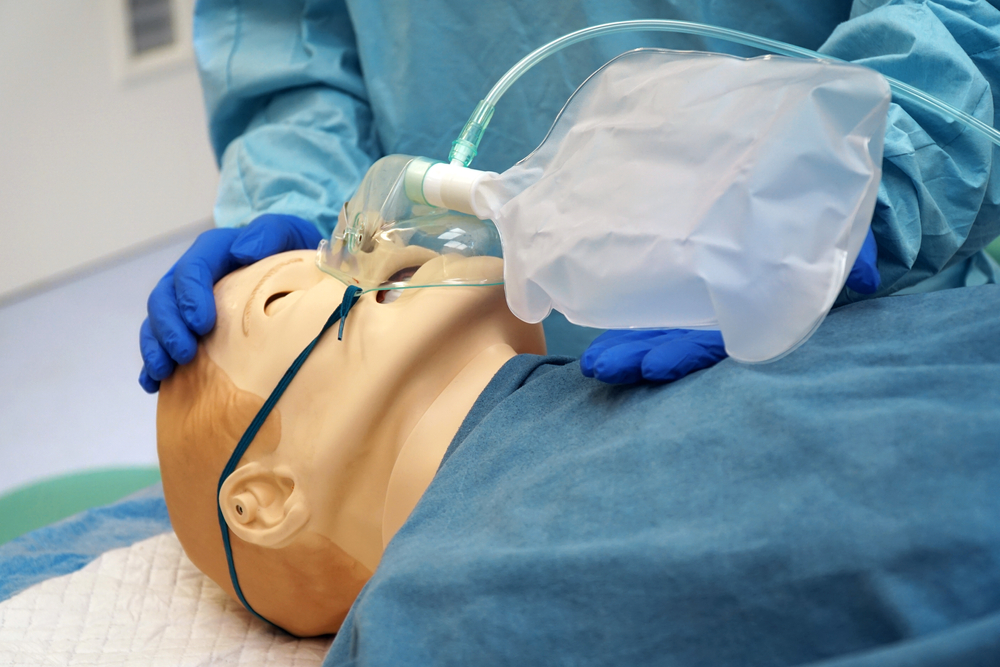Program prepares a hospital for future patient surges
Takeaways:
- Patient surges during the COVID-19 pandemic require nurses who are cross-trained to work in units other than their own.
- A VA system in Oregon developed a nurse cross-training program to prepare outpatient nurses to safely care for patients in the inpatient setting.
- The education team developed a customized learner-driven simulation to meet participants’ need to adhere to CDC and WHO social distancing and PPE recommendations.
- In a course survey, 96% of respondents rated themselves confident or very confident in simulation skills.
When COVID-19 emerged as a domestic medical threat in March 2020, early forecasts predicted increased patient care demands exceeding the current availability of adequately trained inpatient nursing staff at Veterans Affairs Portland Health Care System (VAPORHCS) in Portland, Oregon. To meet this demand and maintain high-quality patient care, a team led by the education division associate chief nurse executive and education division nurse educator (with the support of executive nursing leadership) developed a nurse cross-training (NCT) program to prepare outpatient nurses to safely care for patients in the inpatient setting.
The team (which included subject matter experts in simulation, medical-surgical nursing, safe patient handling and mobility, and pathology and laboratory services, as well as medical library and medical media services staff) identified essential skills for inpatient nursing, evaluated learning needs, and developed curriculum. The learners (RNs and licensed practical nurses) had varied skill sets and nursing backgrounds. To address Centers for Disease Control and Prevention and World Health Organization recommendations for limited face-to-face contact, social distancing, and personal protective equipment, the team created a customized learner-driven simulation to meet participants’ needs.
How we built the program
The NCT team trained the first cohort of nurses from April 2 to May 12, 2020. Educational content was selected from the Office of Nursing Services within the Department of Veterans Affairs, American Nurses Association, The Joint Commission, American Heart Association, VAPORHCS policies and procedures, and Department of Veterans Affairs self-paced online learning tutorials.
Initially, NCT was provided to outpatient nurses who had volunteered and were already working in the medical-surgical units in response to the urgent need for nursing staff. After NCT was implemented, nurses participated in NCT before beginning work on the units.
The self-paced training included online learning, hands-on learning, and high-fidelity simulation. (See Nurse cross-training education). The early days of the pandemic presented some unique challenges, so the participants’ emotional and psychological well-being were addressed throughout training. For example, educators used appreciative inquiry to identify individual learning and emotional needs. Outpatient nurses who went first to the medical-surgical units and then through NCT provided invaluable feedback about how nurse educators could further support psychological well-being. For example, some RNs reported struggling to adapt to the new work environment; they felt like outsiders and lacked confidence in their skills. Educators incorporated these insights into the curriculum, tailoring the education to specific learning needs. Peer mentoring also was offered to ensure staff had a follow-up with an inpatient nurse clinical preceptor and clinical nurse manager after going to inpatient areas. This helped to ease the transition and provided emotional support.
Nurse cross-training education
Veterans Affairs Portland Health Care System (VAPORHCS) is a Magnet®-recognized, 1A tertiary care system that consists of two main medical centers and ten outpatient clinics. The nurse cross-training team at VAPORHCS developed a comprehensive curriculum to prepare nurses from outpatient settings to provide patient care in medical-surgical units during the COVID-19 pandemic.
Prework | Hands-on training | Simulations |
Online training modules
Online nursing procedure modules
| Skill stations
Access and training
| Safe patient handling and mobility Pneumonia scenario |
BCMA = barcoded medication administration, BiPAP = bilevel positive airway pressure, CBG = capillary blood glucose, CPAP = continuous positive airway pressure
Participants independently completed online learning modules before attending the 4-hour hands-on and simulation sessions. Competency skills were verified one-on-one by content experts via repeat demonstration. As an alternative to in-person classes, we created videos of all hands-on skills, which expanded into a virtual platform for distance learning and adherence to social distancing guidelines.
After nurses finished NCT, they completed a competency form to evaluate their proficiency in basic inpatient nursing skills. The form was then given to a preceptor on the medical-surgical unit so they understood the nurses’ proficiency level. The competency form also would help the charge nurse to appropriately assign patient care to the cross-trained nurse.
How we measured our success
We measured the overall value and impact of the program based on participant and nurse manager satisfaction, completion rates, and self-assessed measures of confidence with learned skills. Structural variables included completion rates for pre-work and hands-on training attendance. Training effectiveness evaluations were collected immediately after completing hands-on learning. In addition, surveys were sent to participants and nurse managers 4 months after the first cohort completed training. The voluntary, anonymous surveys asked for recommendations for improvement. Nurse manager surveys measured perceptions of staff preparedness to enter inpatient areas and perceived barriers.
Of the 13 nurse managers (60% represented inpatient units) who responded to the survey, 67% indicated that the nursing staff who floated onto the medical-surgical units were fully prepared to perform basic nursing skills. A suggestion for improvement, which was implemented in subsequent cohorts, was to prioritize training of nurses with medical-surgical experience within the past 5 to 10 years.
Participant surveys were sent to the initial cohort of 93 participants and 26 responded. The low response rate may be related to the 4-month time lapse between training and survey deployment. In addition, only 10% of the nurses were needed to provide direct patient care. Of those respondents, 84% indicated feeling confident or very confident in their ability to float to a medical-surgical unit, 84.5% rated themselves confident or very confident to perform skills in the online training modules, and 73.3% indicated being confident or very confident with hands-on skills. Simulation skills rated the highest, with 96% of respondents saying they felt confident or very confident. A possible explanation for this high rating may be the use of high-fidelity simulation to create a patient situation. Nurses could safely practice and engage in critical thinking, which they could then apply in practice. (See How to conduct a learner-driven simulation.)
How to conduct a learner-driven simulation
Take these steps to create a successful learner-driven simulation curriculum.
- Identify the target audience. Who are the learners?
- Prepare the simulation to reflect the practice areas. Include the same equipment in the simulation lab that’s in the actual practice area.
- Conduct a needs assessment to identify critical skills so you can keep the simulation well-defined and focused.
- Adhere to current infection prevention guidelines—control group sizes, ensure proper personal protective equipment is used, and disinfect the area between groups.
- Customize the plan for individual learners and allow time for self-paced learning.
- Provide a safe environment where learners feel physically and emotionally comfortable.
- Advise participants that they should never worry alone. Discuss the importance of working as a team and identifying resources when assigned to a new or unfamiliar environment.
- Debrief after each session and revise the simulation as needed.
What we learned
Evaluations collected from participants immediately after completing the hands-on learning were used to make immediate program changes and improvements. Nurses who trained toward the end of the program had higher satisfaction and confidence rates than those who trained at the beginning of the program. In addition, NCT evaluations were used to develop similar programs for critical care cross-training (CCCT) and advanced medical-surgical cross-training (AMSCT).
Strengths
The greatest strength of NCT was the use of an interdisciplinary team to quickly develop and implement a comprehensive, evidence-based program in less than 2 weeks. The professional diversity of the team led to well-rounded training, which used different modalities to support adult learning. The team approach was essential to successfully coordinate and implement this complex program, which can now be used for any number of attendees and for any length of time.
In addition, NCT provided an avenue to support nurses’ psychological well-being during a challenging and uncertain time. Although not directly assessed, the team was surprised by the influx of appreciation from nurses who attended the training. It gave them a structured way to help in the early days of the pandemic. NCT provided a solution to a potential staffing shortage and these nurses rose to the challenge. We didn’t need to use temporary staffing organizations or furlough nurses in response to cancelled noncritical services at the beginning of the pandemic.
Barriers
Not knowing the individual experience levels or skill sets of the volunteer nurses was a barrier to curriculum development. The NCT team overcame this barrier by identifying key nursing skills that gave learners enough basic knowledge to safely work in an inpatient setting. The curriculum was flexible, allowing learners to spend more time on unfamiliar skills and less time on those for which they were proficient.
Next steps
CCCT and AMSCT, which were created in response to our NCT success, focus on curriculum that includes advanced nursing skills, higher-intensity situations, and increased use of critical thinking and clinical judgment using complex high-fidelity simulation. NCT is a prerequisite to participating in these advanced programs. Learners for CCCT and AMSCT are chosen in advance and are required to have previous medical-surgical or critical care experience in the past 5 to 10 years.
Prepared for the future
Ultimately, only 10% of NCT participants were needed in the medical-surgical units. After COVID-19 prevalence dropped in the community, nurses returned to their original positions. However, with an uncertain future looming, VAPORHCS is prepared with a pool of trained nurses ready to float to any inpatient unit where nursing assistance is needed.
The authors work at Veterans Affairs Portland Health Care System in Portland, Oregon. Janelle Schira is a nurse educator in the education division. Allison Engle is an evidence-based practice nurse coordinator in nursing professional services. Jennie Fleischmann is associate chief nurse executive, director of the education division. Melissa Schmidt is a clinical nurse leader in perioperative services. Andrea Tachella is a nurse educator in the inpatient and emergency services department.



















1 Comment.
In theory, this seems like a wonderful opportunity for nurses to cross-train to other departments. The reality is med/surg/telemetry nurses are floated to units that aren’t their own without the benefit of a skills prep. period (ie. practicing with the same equipment that is used in other units). My experience has been, no matter how skilled or adaptable a nurse is, floating to other departments can be very stressful.
ie: A telemetry nurse that floats to a surgical unit and has a patient with a PCA or epidural.
A med/surg nurse that floats to telemetry and has a patient with a cardiac issue.
A telemetry nurse that floats to ICU that uses completely different monitoring equipment
and different beds. Little things like bed controls and where supplies are located can be time-consuming and frustrating when a nurse is floated to an unfamiliar unit.